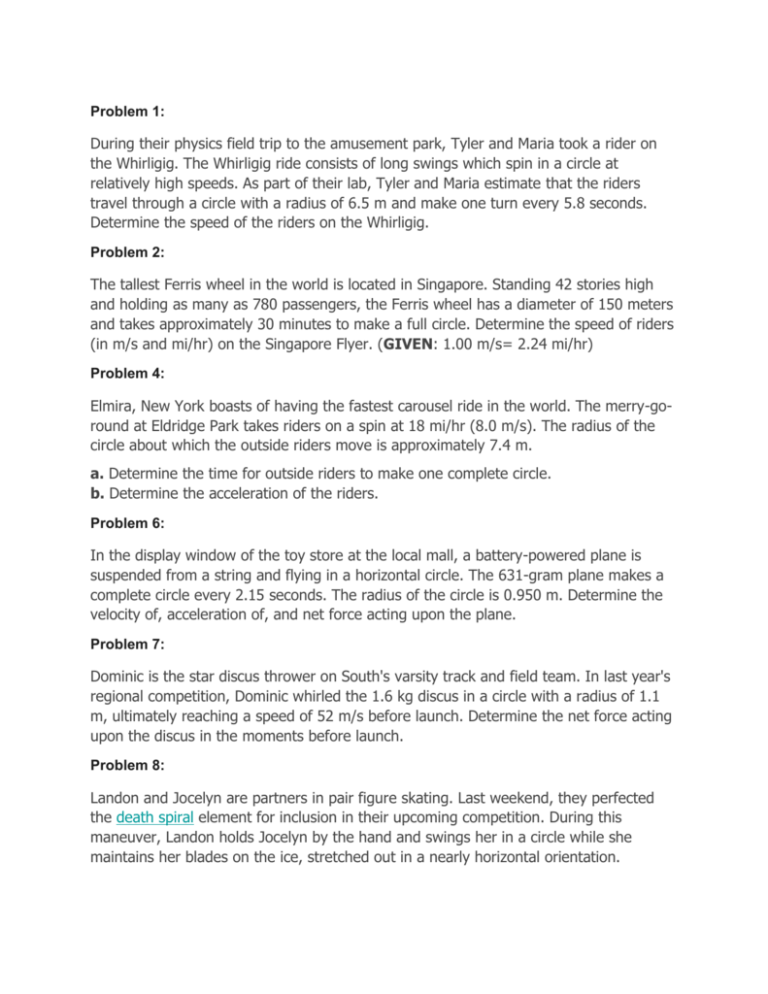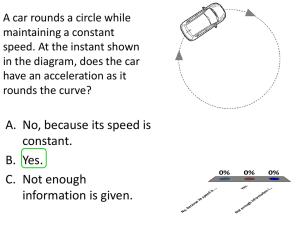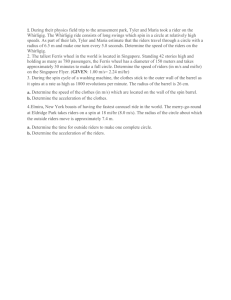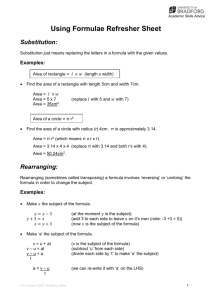Circular Motion Physics Problems Worksheet
advertisement

Problem 1: During their physics field trip to the amusement park, Tyler and Maria took a rider on the Whirligig. The Whirligig ride consists of long swings which spin in a circle at relatively high speeds. As part of their lab, Tyler and Maria estimate that the riders travel through a circle with a radius of 6.5 m and make one turn every 5.8 seconds. Determine the speed of the riders on the Whirligig. Problem 2: The tallest Ferris wheel in the world is located in Singapore. Standing 42 stories high and holding as many as 780 passengers, the Ferris wheel has a diameter of 150 meters and takes approximately 30 minutes to make a full circle. Determine the speed of riders (in m/s and mi/hr) on the Singapore Flyer. (GIVEN: 1.00 m/s= 2.24 mi/hr) Problem 4: Elmira, New York boasts of having the fastest carousel ride in the world. The merry-goround at Eldridge Park takes riders on a spin at 18 mi/hr (8.0 m/s). The radius of the circle about which the outside riders move is approximately 7.4 m. a. Determine the time for outside riders to make one complete circle. b. Determine the acceleration of the riders. Problem 6: In the display window of the toy store at the local mall, a battery-powered plane is suspended from a string and flying in a horizontal circle. The 631-gram plane makes a complete circle every 2.15 seconds. The radius of the circle is 0.950 m. Determine the velocity of, acceleration of, and net force acting upon the plane. Problem 7: Dominic is the star discus thrower on South's varsity track and field team. In last year's regional competition, Dominic whirled the 1.6 kg discus in a circle with a radius of 1.1 m, ultimately reaching a speed of 52 m/s before launch. Determine the net force acting upon the discus in the moments before launch. Problem 8: Landon and Jocelyn are partners in pair figure skating. Last weekend, they perfected the death spiral element for inclusion in their upcoming competition. During this maneuver, Landon holds Jocelyn by the hand and swings her in a circle while she maintains her blades on the ice, stretched out in a nearly horizontal orientation. Determine the net force which must be applied to Jocelyn (m=51 kg) if her center of mass rotates in a circle with a radius of 61 cm once every 1.9 seconds. 3. A merry-go-round with a radius of 5.0 m starts from rest and accelerates at a uniform rate for 5.0 s until the outer rim of the merry go round has speed 3.0 m/s. What is the angular acceleration of the merry-go-round, in rad/s2 ? A) 0.030 B) 0.12 C) 0.30 D) 0.60 E) 3.0 9. A race car goes around a flat track in the clockwise direction. At the point shown in the figure at the right the car is slowing down. What is the direction of its acceleration vector? A) A B) B C) C D) D E) E Questions 15, 16, and 17. A child weighing 220 N is swinging back and forth on a rope attached to a tree branch. The rope is 3.8 m long and has negligible mass. 15. What is the magnitude of the child’s acceleration at the highest point of the swing, assuming the rope makes an angle θ with respect to the vertical at that point? The acceleration of gravity is g. A) g sin θ B) g cos θ C) g tan θ D) g cot θ E) It can’t be determined without knowing the speed at the bottom of the swing 16. When the child is at the lowest point of the swing the tension in the rope is 360 N. What is the child’s speed at that point, in m/s? A) 0 B) 6.3 C) 2.1 D) 8.7 E) 4.9 Answers to questions 1. 7.0 m/s 2. 0.26 m/s or 0.59 mi/hr 4 a. 5.8 s b. 8.7 m/s/s 6. velocity: 2.78 m/s acceleration: 8.11 m/s/s net force: 5.12 N 7. 3.9 x 103 N 8. 340 N 3. Solution: The angular acceleration is α = Δω / Δt . To find the change in angular velocity, we use the relationship between angular and tangential velocity, ω = v / R , so α = Δv / R / Δt = (3.0)/(5.0)/(5.0) = 0.12 rad/s 2 . Answer: B. 9. Solution: The car is turning to its left, which implies the centripetal acceleration (normal to the direction of motion) is to its left (upwards in the figure, directions A or B). Since it is also slowing down, the tangential acceleration must oppose the motion, which means the tangential component is to the left in the figure. Since there is both a tangential and normal component, the direction is given by vector B. Answer: B. 15. Solution: The two forces acting are the tension in the rope and gravity. The free body diagram is shown below. Resolving the forces into their radial and tangential components we have: T - mgcosθ = m*a_radial = mv^2 / R mgsin θ = ma_tangential . At the highest point of the motion, the velocity is zero, so at that instant there is no radial component to the acceleration 16. Solution: We can use the radial equation from the previous problem, set θ = 0 (the angle at the lowest point) and solve for the speed (using the fact that the weight is w = mg, or m = w/g): v = √𝑔𝑅(𝑇 − 𝑚𝑔𝑐𝑜𝑠𝜃)/ 𝑤 = √(9.8)(3.8)(360 − 220𝑐𝑜𝑠0°)/ 220 = 4.9 𝑚/𝑠. Answer: E. 17. n. Thus the only acceleration is tangential and a = g sin θ. Answer: A.








